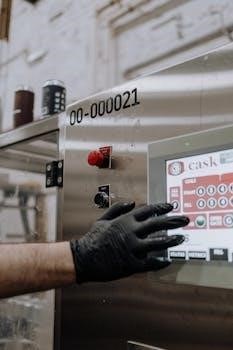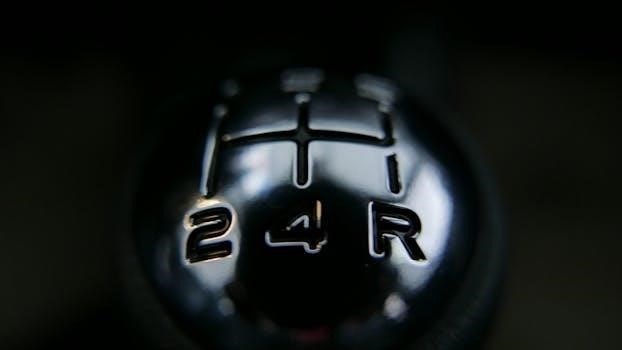
This manual provides comprehensive instructions for the Tekonsha Prodigy P2 electronic brake controller. It covers installation, wiring, mounting, operation, and troubleshooting, ensuring safe and effective trailer braking. Keep this guide for future reference to maintain optimal performance and understand its features.
The Prodigy P2 is a sophisticated electronic brake controller designed for trailers with 2, 4, 6, or 8 brakes. This controller utilizes advanced proportional braking technology, responding to the intensity and rate at which the tow vehicle’s brakes are applied, providing a smooth and controlled braking experience. The internal inertia sensor is the core of its proportional braking capability, ensuring braking force mirrors the tow vehicle. This makes the Prodigy P2 suitable for diverse braking situations. The device features a unique connector on the back, offering two wiring options for flexible installation. The display on the P2 will automatically enter a suspension mode after 20-30 minutes of inactivity, preserving power. Understanding the components and operation of the Prodigy P2 is essential to ensure its safe and effective use. This manual will guide you through the installation and operation process.

Components of the Prodigy P2
The Prodigy P2 brake controller is composed of several key components that contribute to its functionality. These components are essential for proper operation and user interaction. The first is the Power Knob, which is used to adjust the braking power output to the trailer brakes. Next is the Boost Button, which allows the user to select different levels of braking intensity based on their preference, towing situation and the condition of the trailer brakes. The Manual Knob is another key component, which enables the user to manually apply the trailer brakes. Lastly, there is the Connector for Wiring Harness, located at the back of the control, it provides options for connecting the brake controller to the vehicle’s wiring system. Familiarization with these components is vital for understanding how the P2 operates and for making necessary adjustments.
Power Knob
The Power Knob on the Prodigy P2 is a crucial component that allows users to regulate the amount of braking force applied to the trailer’s brakes. This knob functions as a primary control for adjusting the overall braking intensity. Turning the knob clockwise increases the power output, resulting in stronger braking, while turning it counterclockwise decreases the power output, leading to reduced braking force. The power knob enables users to fine-tune the braking to match the specific requirements of their towing setup, taking into consideration factors such as trailer weight, road conditions, and personal preferences. It’s important to adjust this knob appropriately to ensure smooth and safe braking performance. The user must adjust the knob to have a smooth and proportional braking response. This is done by turning the knob until the trailer brakes engage smoothly and effectively without locking up or being too weak.
Boost Button
The Boost Button on the Prodigy P2 serves as a supplementary control mechanism to enhance the braking force applied to the trailer. This feature is particularly useful in situations that demand extra stopping power, such as when towing a heavy load or descending a steep incline. The Boost Button allows users to select from different levels of boost, effectively amplifying the braking output beyond the regular setting. By pressing the button, the user can quickly increase the braking force. The different boost levels provide options to fine-tune the braking response to match various driving scenarios. It’s essential to use this feature judiciously, as excessive boost can result in abrupt or jerky braking. The Boost Button provides added braking power which the user can use when needed. This is a valuable feature for safety and control in demanding situations. The user should select the boost setting based on their preferences.
Manual Knob
The Manual Knob on the Prodigy P2 provides the user with direct, hands-on control over the trailer’s braking system, independent of the tow vehicle’s brakes. This allows for a controlled and immediate application of trailer brakes. By rotating the manual knob, users can manually adjust the braking force applied to the trailer. This is particularly useful in situations such as stabilizing a swaying trailer or applying brakes gradually before the tow vehicle’s brakes are engaged. The manual knob allows for an immediate braking application which the user can use as required. The manual control is a very handy feature which allows the user to manually control the trailer brakes as needed. It’s also helpful for testing the trailer brakes before a trip or during brake adjustments. The manual knob is essential for situations where a user needs to manually control the braking force of the trailer. The user should use it carefully and deliberately.
Connector for Wiring Harness
The Prodigy P2 features a unique connector located at the rear of the unit, specifically designed for attaching the wiring harness. This connector serves as the crucial interface for establishing the electrical connection between the brake controller and the vehicle’s braking system. This connector allows for two options when wiring the unit. This design ensures a secure and reliable connection, which is essential for the proper functioning of the brake control system. It provides a designated point for the user to make all the necessary electrical connections. The connector simplifies the wiring process by providing a single, easily accessible point for all connections. The user must ensure the wiring is properly connected and secure. The connector facilitates both the power supply to the unit and the signal transfer to the trailer brakes. It also ensures proper data transmission. The connector is designed to withstand the vibrations and harsh conditions associated with towing.
Wiring Options
The Prodigy P2 brake controller offers two primary wiring options to facilitate installation into various vehicle setups. These options are designed to accommodate different user preferences and existing vehicle wiring configurations. The main aim is to ensure a safe and reliable connection between the tow vehicle and the trailer braking system. The first option involves utilizing the pigtail wiring harness, which is often included with the Prodigy P2 unit. This harness offers a straightforward method for connecting to your vehicle’s brake controller wiring. The second option involves direct wiring, which might be preferred in certain scenarios. This approach requires a more detailed understanding of the electrical system. Both options must be carefully implemented to ensure safe and effective braking. Incorrect wiring can lead to malfunction or damage. Always refer to the appropriate wiring diagrams and instructions to avoid any complications. Proper wiring is critical for the brake controller to operate correctly. The user must be aware of the risk of improper installation.
Pigtail Wiring Harness
The pigtail wiring harness offers a convenient and generally straightforward method for connecting your Prodigy P2 brake controller to your tow vehicle’s electrical system. This harness typically consists of a pre-wired connector that plugs directly into the back of the Prodigy P2 unit, with color-coded wires extending from the connector for easy identification. Each wire in the harness serves a specific purpose, such as providing power, connecting to the brake light switch, and supplying the signal to the trailer’s brakes. Proper identification and connection of each wire is essential for the brake controller to function correctly. The use of a pigtail harness simplifies the installation process, reducing the likelihood of incorrect wiring connections. It’s crucial to refer to the wiring diagram and your vehicle’s documentation to ensure that each wire is connected to the correct circuit. A secure connection and proper insulation of all wires are also necessary to ensure long-term reliability and safe operation. This method is considered more user friendly.
Mounting Guidelines
Proper mounting of the Prodigy P2 brake controller is critical for its accurate and safe operation. The controller should be mounted in a location that allows the internal sensor to properly detect deceleration, typically within the vehicle’s cab. It must be securely fastened to prevent movement during vehicle operation, which could lead to inaccurate braking performance. The mounting location should be easily accessible for adjusting settings and monitoring the display. Avoid mounting in areas that could be obstructed or exposed to extreme temperatures, direct sunlight, or moisture. The suggested mounting position is usually under the dash where it is protected and easily viewed. Ensure that the controller is oriented correctly to function as intended and is within the specified mounting angles as per the manufacturer’s diagram to ensure accurate readings. It’s also important to ensure that no RF generating devices, like cell phones, are mounted within 12 inches of the brake controller. Following these mounting guidelines will help maintain the accuracy and reliability of the controller.
Operation and Display
The Prodigy P2’s display provides crucial information about its operation. The unit automatically enters a suspension mode after about 20 to 30 minutes of inactivity, meaning no brake pedal application or manual lever activation. This is a normal function and is designed to save power. The display also shows the voltage output, ranging from 0.0 to 13 volts, which indicates the power being sent to the trailer brakes. The display will show various codes such as “PL” if a power loss on the black wire is detected, often caused by connecting the unit to power while the brake pedal or manual lever is activated. Users should familiarize themselves with the different display indicators to effectively operate and troubleshoot the Prodigy P2. The boost button allows drivers to adjust braking intensity to suit various driving conditions. Understanding how to use the power knob, boost button, and manual knob is essential for safe and controlled braking.
Suspension Mode
The Prodigy P2 features an automatic suspension mode designed to conserve power during periods of inactivity. This mode engages after approximately 20 to 30 minutes of no brake pedal application or manual lever usage. When the controller enters suspension mode, the display will turn off, indicating that it is in a low-power state. The suspension mode is a normal operational function and does not signify any malfunction or issue with the device. It is important to note that the unit will quickly return to active operation when the brake pedal is pressed or the manual lever is activated. The automatic suspension mode is an important feature of the Prodigy P2 as it helps to reduce the drain on the vehicle’s electrical system during periods of non-use. This feature will not affect the performance or safety of the controller.

Voltage Output
The Prodigy P2 displays voltage output to the trailer’s electric brakes, ranging from 0.0 to 13 volts. This reading provides an indication of the electrical power being sent to the trailer’s braking system. The voltage output is directly related to the braking force applied, with higher voltage resulting in stronger braking. The display allows users to monitor the voltage being delivered during braking, helping to ensure the correct function of the trailer brakes. This real-time voltage indication is helpful in assessing the braking performance and identifying any potential issues. The proportional braking technology of the Prodigy P2 modulates the voltage output, providing smooth and controlled braking. It is important to be aware of the voltage displayed during braking to maintain proper brake operation and safety. The voltage range ensures compatibility with various electric brake systems.

PL Error Code
The Prodigy P2 displays a “PL” error code when it detects a power loss on the black wire. This error typically indicates a problem with the power supply to the brake controller. This can occur if the brake pedal or manual lever is activated while connecting the P2 to power, causing a momentary disruption. Other possible causes include loose connections or a faulty wiring harness. Troubleshooting the PL error involves verifying all wiring connections, ensuring the black wire has a secure connection to the power source. It is also important to check the vehicle’s wiring harness for any damage or shorts. Resolving a PL error is essential for proper brake controller function. If the problem persists, consult a professional technician. Ignoring a PL code may result in improper brake functionality. The PL code is a safety feature to ensure the brake system is properly connected and functioning.
Proportional Braking Technology
The Prodigy P2 utilizes advanced proportional braking technology, which is central to its smooth and responsive performance. This technology relies on an internal inertia sensor that detects the deceleration rate of the tow vehicle. It then applies the trailer brakes proportionally to the intensity and rate at which the tow vehicle’s brakes are engaged. This means that the harder you brake, the harder the trailer brakes will apply, and vice-versa. This ensures a seamless and synchronized braking experience. The proportional braking system also functions in reverse, applying the appropriate brake force. The system eliminates the jarring effect often associated with traditional time-delayed brake controllers. It provides a more controlled and confident towing experience by ensuring braking is smooth and consistent. The proportional technology makes the Prodigy P2 ideal for diverse towing conditions and driving styles, offering enhanced safety and control.

